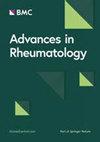Tuberculin skin test repetition after TNF-α inhibitors in patients with chronic inflammatory arthritis: a long-term retrospective cohort in endemic area
IF 2.1
4区 医学
Q3 RHEUMATOLOGY
引用次数: 0
Abstract
To evaluate the tuberculin skin test (TST) conversion in chronic inflammatory arthropathies (CIA) patients on TNFα inhibitors (TNFi) and without previous latent tuberculosis infection (LTBI) treatment. Patients with rheumatoid arthritis (RA), ankylosing spondylitis (AS) and psoriatic arthritis (PsA) with negative LTBI were retrospectively evaluated for TST conversion and active tuberculosis (TB) after six months of exposition to TNFi. Two groups were compared: patients who repeated TST (TST-repetition) during the follow-up and patients who did not (non-TST-repetition). A total of 355 CIA patients on TNFi were screened and 138 (38.9%) did not fulfill the inclusion criteria. Of the remaining 217 CIA patients, 81 (37.3%) repeated TST during TNFi treatment. TST conversion rate was observed in 18 (22.2%) patients without significant differences among CIA (p = 0.578). The number of TB cases was low (n = 10; 4.6%) and was similar in TST-repetition and non-TST-repetition groups [2 (2.5%) vs. 8 (5.9%), p = 0.328]. Of note, 30% of active TB occurred early (6–12 months of TNFi exposure) and the median (full range) time to incident TB was 1.3 (0.6–10.6) years, whereas the median (full range) time to TST repetition was later [3.3 (0.5–13.4) years]. The incidence of active TB was lower among RA patients than AS patients [342 (95% CI 41 − 1446) vs. 1.454 (95% CI 594-2993)/100,000 patient-years, p = 0.049]. These results indicate that TST repetition is associated with a high conversion rate, suggesting the need for recommended treatment. The delayed repetition of TST and low number of active TB cases hampered the evaluation of this strategy effectiveness to prevent active infection. Larger studies with systematic repetition patterns are necessary. In addition, the study highlights the need for a greater surveillance for TB in AS patients. • TST repetition is associated with a high conversion rate for positive LTBI after long-term TNFi. • Active tuberculosis diagnosis occurs early (1.3 years) during TNFi therapy. • AS patients require greater surveillance for incident TB.慢性炎症性关节炎患者服用 TNF-α 抑制剂后重复结核菌素皮试:流行区的长期回顾性队列研究
目的:评估使用 TNFα 抑制剂(TNFi)且未接受过潜伏结核感染(LTBI)治疗的慢性炎症性关节病(CIA)患者的结核菌素皮试(TST)转换情况。对LTBI阴性的类风湿性关节炎(RA)、强直性脊柱炎(AS)和银屑病关节炎(PsA)患者在接受TNFi治疗6个月后的TST转换和活动性结核(TB)情况进行了回顾性评估。两组患者进行了比较:在随访期间重复TST(重复TST)的患者和未重复TST(未重复TST)的患者。共筛选出355名使用TNFi的CIA患者,其中138人(38.9%)不符合纳入标准。在剩余的217名CIA患者中,有81人(37.3%)在TNFi治疗期间重复了TST。18名(22.2%)患者的TST转阴率在CIA之间无显著差异(P = 0.578)。结核病例数较少(n = 10;4.6%),TST重复组和非TST重复组的结核病例数相似[2 (2.5%) vs. 8 (5.9%),p = 0.328]。值得注意的是,30%的活动性肺结核发生在早期(TNFi暴露后6-12个月),发生肺结核的中位(全范围)时间为1.3(0.6-10.6)年,而重复TST的中位(全范围)时间较晚[3.3(0.5-13.4)年]。RA患者的活动性肺结核发病率低于AS患者[342 (95% CI 41 - 1446) vs. 1.454 (95% CI 594-2993)/100,000患者年,p = 0.049]。这些结果表明,TST 的重复与高转换率相关,表明需要进行推荐治疗。由于重复 TST 的时间较晚,且活动性肺结核病例较少,因此无法评估该策略在预防活动性感染方面的有效性。有必要进行更大规模的系统重复模式研究。此外,该研究还强调了加强对 AS 患者结核病监测的必要性。- TST重复检测与长期TNFi治疗后LTBI阳性的高转化率有关。- 活动性肺结核诊断在TNFi治疗期间较早(1.3年)出现。- AS患者需要加强对结核病的监测。
本文章由计算机程序翻译,如有差异,请以英文原文为准。
求助全文
约1分钟内获得全文
求助全文
来源期刊

Advances in Rheumatology
Medicine-Rheumatology
CiteScore
4.00
自引率
4.30%
发文量
41
审稿时长
53 weeks
期刊介绍:
Formerly named Revista Brasileira de Reumatologia, the journal is celebrating its 60th year of publication.
Advances in Rheumatology is an international, open access journal publishing pre-clinical, translational and clinical studies on all aspects of paediatric and adult rheumatic diseases, including degenerative, inflammatory and autoimmune conditions. The journal is the official publication of the Brazilian Society of Rheumatology and welcomes original research (including systematic reviews and meta-analyses), literature reviews, guidelines and letters arising from published material.
 求助内容:
求助内容: 应助结果提醒方式:
应助结果提醒方式:


